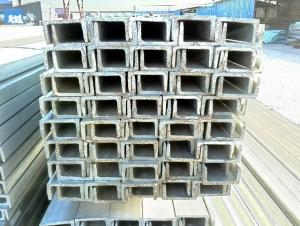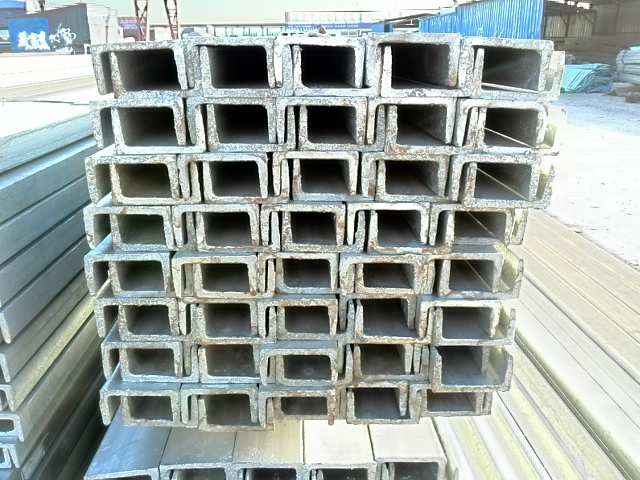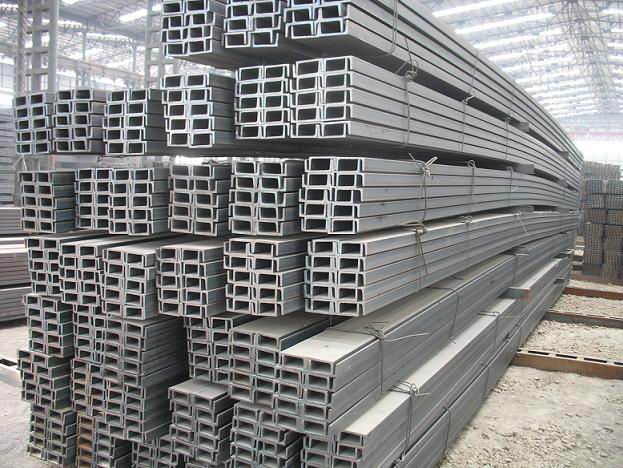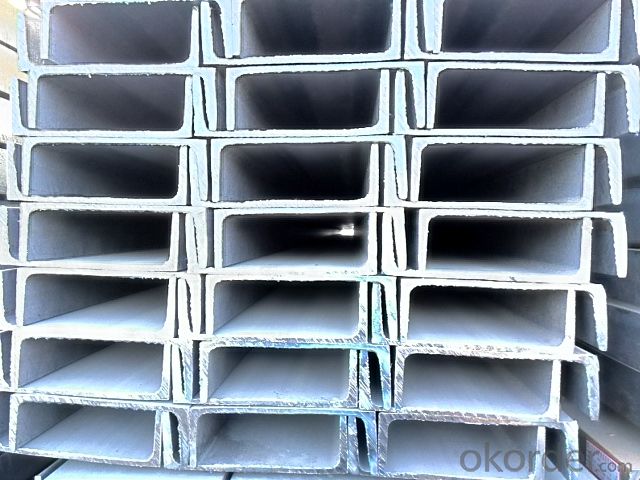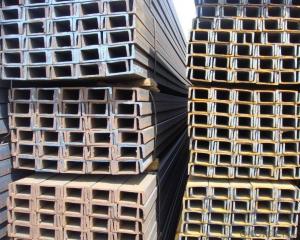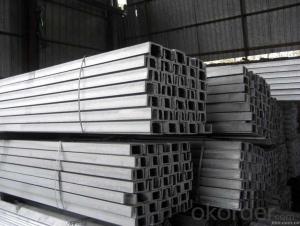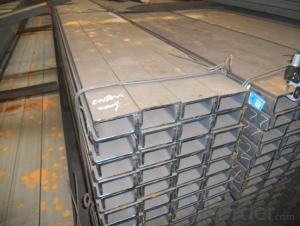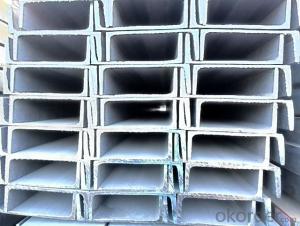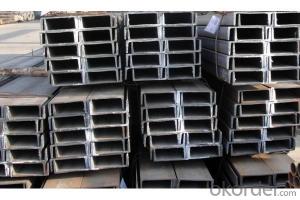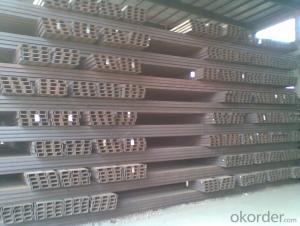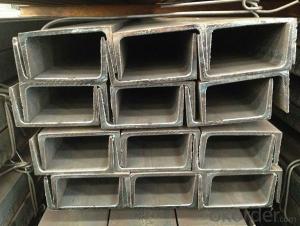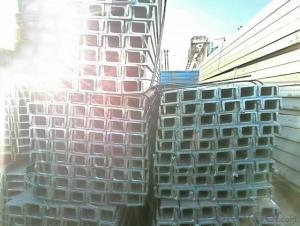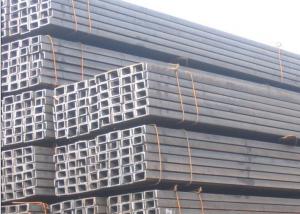JIS U Channels Beams for Structures Buildings Making
- Loading Port:
- Tianjin
- Payment Terms:
- TT OR LC
- Min Order Qty:
- 25 m.t
- Supply Capability:
- 10000 m.t/month
OKorder Service Pledge
OKorder Financial Service
You Might Also Like
Product Description:
| Minimum Order Quantity: | 25MT | Unit: | m.t. | Loading Port: | Xingang Port |
| Supply Ability: | 120000TON/Year | Payment Terms: | TT or LC |
Product Applications:
Japanese Standard U-channels are ideal for structural applications and are widely used in the construction of buildings and bridges, and the manufacturing, petrochemical, and transportation industries.
Product Advantages:
OKorder's Japanese Standard U-channels are durable, strong, and resist corrosion.
Main Product Features:
· Premium quality
· Prompt delivery & seaworthy packing (30 days after receiving deposit)
· Corrosion resistance
· Can be recycled and reused
· Mill test certification
· Professional Service
· Competitive pricing
Product Specifications:
Manufacture: Hot rolled
Grade: Q195 – 235
Certificates: ISO, SGS, BV, CIQ
Length: 6m – 12m, as per customer request
Packaging: Export packing, nude packing, bundled
1. We are definitely speciallizing in manufacturing and supplying channel steel as per japanese standard, which is characterised with high mechanical strength and competitive prices.
Original Place | Tangshan, China | Brand Name | UINDA |
Standard | JIS G3192 : 1990 | ||
Material Grade | SS490 | ||
Sizes | 50mm to 200mm | ||
Sales Volume/Year | 3000MT | ||
Destination Area | Middle East, Africa, Southeast Asia | ||
2. The sections in details are as followings in the table-1
JIS U CHANNEL | Standard | Sectional | Dimension |
| Mass: |
| (mm) | (mm) | (mm) | (mm) |
|
50x25 | 50 | 25 | 3.0 | 6.00 | 2.37 |
75X40 | 75 | 40 | 3.8 | 7.00 | 5.30 |
75X40 | 75 | 40 | 4.0 | 7.00 | 5.60 |
75X40 | 75 | 40 | 4.5 | 7.00 | 5.85 |
75X40 | 75 | 40 | 5.0 | 7.00 | 6.92 |
|
|
|
|
|
|
100X50 | 100 | 50 | 3.8 | 6.00 | 7.30 |
100X50 | 100 | 50 | 4.2 | 6.00 | 8.03 |
100X50 | 100 | 50 | 4.5 | 7.50 | 8.97 |
100X50 | 100 | 50 | 5.0 | 7.50 | 9.36 |
|
|
|
|
|
|
125X65 | 125 | 65 | 5.2 | 6.80 | 11.66 |
125X65 | 125 | 65 | 5.3 | 6.80 | 12.17 |
125X65 | 125 | 65 | 5.5 | 8.00 | 12.91 |
125X65 | 125 | 65 | 6.0 | 8.00 | 13.40 |
|
|
|
|
|
|
150x75 | 150 | 75 | 5.5 | 7.30 | 14.66 |
150x75 | 150 | 75 | 5.7 | 10.00 | 16.71 |
150x75 | 150 | 75 | 6.0 | 10.00 | 17.90 |
150x75 | 150 | 75 | 6.5 | 10.00 | 18.60 |
150x75 | 150 | 75 | 6.5 | 10.00 | 24.00 |
|
|
|
|
|
|
200X80 | 200 | 80 | 7.5 | 11.00 | 24.60 |
Table-1
3. The mechanical property of JIS U Channel Steel in the table-2:
Grade | Yield Strength,N/mm² | Extension Strength N/mm² | |||
Thickness of Steel,mm | |||||
≦16 | >16-≦40 | >40-≦100 | >100 | ||
SS490 | ≧285 | ≧275 | ≧255 | ≧245 | 490-610 |
Table-2
4. The chemical composition of JIS U Channel Steel as per SS490 in the table-3
Grade | Element(%) | |||
C | Mn | P | S | |
SS490 | - | - | ≦0.050 | ≦0.050 |
Table-3
FAQ:
Q1: Why buy Materials & Equipment from OKorder.com?
A1: All products offered byOKorder.com are carefully selected from China's most reliable manufacturing enterprises. Through its ISO certifications, OKorder.com adheres to the highest standards and a commitment to supply chain safety and customer satisfaction.
Q2: How do we guarantee the quality of our products?
A2: We have established an advanced quality management system which conducts strict quality tests at every step, from raw materials to the final product. At the same time, we provide extensive follow-up service assurances as required.
Q3: The products are invoicing on theoritical weight or on actual weight?
A3: We can do it in both manners, according to the customers' request.
Images:
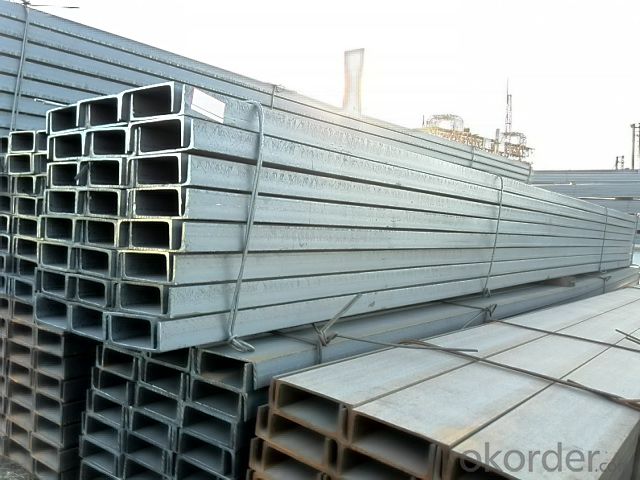
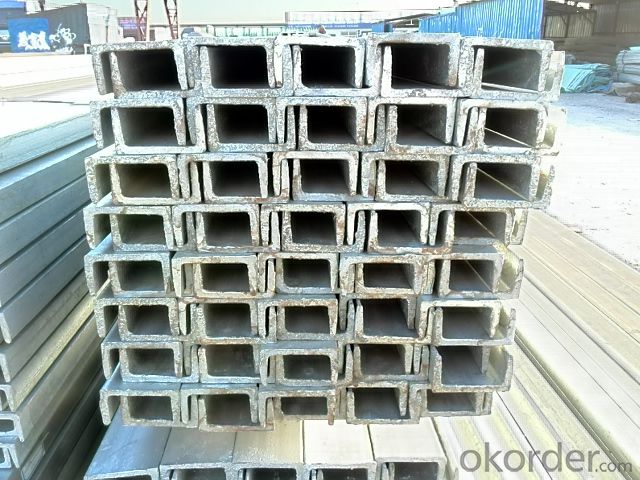
- Q: Is it OK to use the channel steel to do the Overhanging Scaffold? Is there any difference between the cantilever scaffold made of I-beam and channel steel?
- Personally think that as long as the channel can withstand the weight of scaffolding on the line, but also consider the case of falling things momentum
- Q: What are the different types of clamps used for steel channels?
- There are several different types of clamps that are commonly used for steel channels, each serving a specific purpose. These clamps are designed to securely fasten and support steel channels, ensuring stability and structural integrity in various applications. 1. Beam clamps: Beam clamps are specifically designed to attach steel channels to beams or other structural members. They typically feature a screw or bolt mechanism that allows for easy installation and adjustment, providing a secure attachment point. 2. U-bolt clamps: U-bolt clamps are shaped like a U and are used to secure steel channels to pipes, rods, or other cylindrical objects. They provide a strong and reliable connection, often used in applications where there is a need to attach channels to round or curved surfaces. 3. Pipe clamps: Pipe clamps are commonly used to support steel channels that are attached to pipes. They typically have a split design that allows for easy installation around the pipe, with screws or bolts to secure the clamp to the channel. 4. Rigid clamps: Rigid clamps are heavy-duty clamps designed for applications where maximum strength and stability are required. They provide a rigid connection between steel channels and other structural components, ensuring minimal movement or flexing. 5. Channel clamps: Channel clamps are specifically designed to connect two steel channels together. They often feature a sliding mechanism that allows for easy adjustment and alignment, ensuring a secure and precise connection. In addition to these specific types of clamps, there may be variations or specialized clamps available for specific applications or requirements. It is important to choose the appropriate clamp based on the specific needs of the steel channel installation to ensure proper support and durability.
- Q: Calculated weight of channel steel
- A calculating example channel (kg/m) W=0.00785 * [hd+2t (B? C D (+0.349) R2? C R 2 m h=) per channel] weight high b= leg length d= t= average thickness of R= thick waist leg inner arc radius r= end arc radius for 80 mm * 43mm * 5mm. From the metallurgical products directory found the channel of T is 8, R is 8, R is 4, per M weight =0.00785 * [80 * 5+2 * 8 * (43? 5 C) * +0.349 (82? C4 2)]= 8.04kg
- Q: What are the different corrosion protection methods for steel channels in marine environments?
- Steel channels in marine environments face a high risk of corrosion due to the presence of saltwater and harsh elements. To protect against corrosion, there are several methods available: 1. Coating: Applying protective coatings, such as epoxy, polyurethane, and zinc-rich paints, creates a barrier between the steel surface and corrosive elements. This prevents direct contact and subsequent corrosion. 2. Cathodic protection: This method utilizes sacrificial anodes or impressed current to safeguard steel channels. Sacrificial anodes made of zinc or aluminum are attached to the steel channels and corrode preferentially, sacrificing themselves to protect the steel. Impressed current systems use an external power source to provide a protective electrical current. 3. Galvanization: Galvanizing steel channels involves coating them with a layer of zinc, which acts as a sacrificial layer. This sacrificial layer corrodes instead of the steel, providing protection against corrosion in marine environments. 4. Stainless steel: Utilizing stainless steel channels is another effective method. Stainless steel contains chromium, which forms a passive oxide layer on the surface, safeguarding against corrosion. It is highly resistant to corrosion in marine environments and commonly used in critical applications. 5. Proper maintenance: Regular inspection, maintenance, and upkeep are crucial to prevent corrosion in steel channels. This includes removing marine growth, repairing coating damage, and ensuring proper drainage and ventilation to minimize exposure to corrosive elements. It is important to consider factors such as the severity of the marine environment, duration of exposure, and expected lifespan of the steel channels when selecting a corrosion protection method. Consulting corrosion engineers or specialists can assist in determining the most suitable protection method for specific marine applications.
- Q: Can steel channels be used for staircases?
- Yes, steel channels can be used for staircases. Steel channels are often used in construction for their strength and durability. They can provide a sturdy framework for staircases and help support the weight of individuals using the stairs. Additionally, steel channels can be customized to fit the specific dimensions and design requirements of the staircase. They can also be fabricated with various finishes and coatings to enhance their appearance and protect against corrosion. Overall, steel channels offer a reliable and versatile option for constructing staircases.
- Q: Can steel channels be customized to specific dimensions?
- Certainly, specific dimensions can be achieved when customizing steel channels. Steel channels possess versatility, allowing them to be tailored to meet specific width, height, and thickness requirements. This customization is accomplished through a range of manufacturing techniques such as cutting, bending, and welding. By modifying these dimensions, steel channels can be perfectly suited to fit particular applications and structural necessities. Whether it be for construction, machinery, or any other industry, steel channels offer the flexibility to meet desired dimensions and specifications when customized.
- Q: What are the common surface finishes available for steel channels?
- There are several common surface finishes available for steel channels. These finishes are applied to the surface of the steel channels to enhance their appearance, protect them from corrosion, and improve their durability. One common surface finish for steel channels is a plain or mill finish. This finish is achieved by leaving the steel channels in their natural state after they have been manufactured. It has a smooth and slightly reflective surface, but it does not provide any additional protection against corrosion. Another common surface finish is hot-dip galvanizing. This process involves immersing the steel channels in a bath of molten zinc, which forms a protective coating on the surface. Hot-dip galvanized steel channels have a dull gray appearance and provide excellent corrosion resistance, making them suitable for outdoor or high-moisture environments. Powder coating is also a popular surface finish for steel channels. In this process, a dry powder is electrostatically applied to the surface of the channels and then cured under heat. Powder-coated steel channels have a smooth and durable finish that is available in a wide range of colors. This finish provides good corrosion resistance and is commonly used for indoor applications. Additionally, steel channels can be painted using various types of paint finishes. These finishes can be applied by spray painting, roller painting, or brush painting. Painted steel channels offer aesthetic appeal and can be customized to match specific color requirements. They also provide some protection against corrosion, although the level of protection may vary depending on the quality of the paint and the application process. In conclusion, the common surface finishes available for steel channels include plain or mill finish, hot-dip galvanizing, powder coating, and paint finishes. Each finish offers different benefits in terms of appearance, corrosion resistance, and durability. The choice of surface finish depends on the specific requirements of the application and the desired outcome.
- Q: Which bearing capacity is stronger?
- Under the same thickness, the bearing capacity of I-beam will be better than that of channel steel, and the price of channel steel will be lower than that of i-beam.
- Q: What are the different types of corrosion protection for steel channels?
- There are several different types of corrosion protection methods available for steel channels, depending on the specific requirements and environmental conditions. Some of the common methods are: 1. Galvanization: This is one of the most popular methods of corrosion protection for steel channels. In this process, the channels are coated with a layer of zinc, which acts as a sacrificial anode and prevents corrosion by corroding itself instead of the steel. 2. Powder coating: Powder coating involves applying a dry powder to the channels and then baking it in an oven to create a protective layer. This method provides excellent corrosion resistance and can also enhance the aesthetics of the channels. 3. Epoxy coatings: Epoxy coatings are commonly used for corrosion protection in aggressive environments. These coatings form a strong and durable barrier against moisture and chemical exposure, preventing the steel channels from corroding. 4. Paint coatings: Paint coatings can provide a cost-effective solution for corrosion protection. Multiple layers of paint are applied to the steel channels, creating a barrier between the metal and the corrosive elements in the environment. 5. Hot-dip galvanizing: Similar to galvanization, hot-dip galvanizing involves immersing the steel channels in a bath of molten zinc. This process provides a thicker and more durable layer of protection compared to regular galvanization. 6. Cathodic protection: Cathodic protection is a technique used to protect steel channels by making them the cathode in a corrosion cell. This is achieved by connecting the channels to a sacrificial anode, such as zinc or magnesium, which corrodes instead of the steel. 7. Stainless steel: Using stainless steel channels is another effective way to prevent corrosion. Stainless steel contains a high percentage of chromium, which forms a passive oxide layer on the surface, protecting it from corrosion. It is important to choose the appropriate corrosion protection method based on factors such as the environment, expected lifespan, and cost considerations to ensure the longevity and durability of steel channels.
- Q: What are the different surface treatments for steel channels?
- Some common surface treatments for steel channels include galvanizing, painting, powder coating, and applying a protective coating.
Send your message to us
JIS U Channels Beams for Structures Buildings Making
- Loading Port:
- Tianjin
- Payment Terms:
- TT OR LC
- Min Order Qty:
- 25 m.t
- Supply Capability:
- 10000 m.t/month
OKorder Service Pledge
OKorder Financial Service
Similar products
Hot products
Hot Searches
Related keywords
